There’s something about vibrant veggies, creamy sauce, and perfectly cooked pasta that just hits the spot. My Fresh Vegetable Pasta Primavera Recipe is a celebration of spring and summer veggies, bursting with flavor and color that’s as fresh as it is comforting. Let me walk you through why this dish is a keeper and how to nail it at home.
Jump to:
Why You'll Love This Recipe
I’ve made this Fresh Vegetable Pasta Primavera Recipe more times than I can count, and it never gets old. The balance of tender-crisp veggies with a velvety herb-laced sauce makes it feel both special and surprisingly easy. It’s also incredibly versatile, perfect for any weeknight or when friends drop by unexpectedly.
- Fresh and Vibrant: The combination of seasonal vegetables makes every bite colorful and full of natural sweetness.
- Creamy Yet Light: The sauce uses heavy cream balanced with lemon juice to keep things luscious without feeling heavy.
- Simple Techniques: With just a few easy-to-follow steps, you’ll impress yourself—and anyone you serve it to!
- Flexible and Customizable: Swap veggies or add protein based on what you have on hand or what you’re in the mood for.
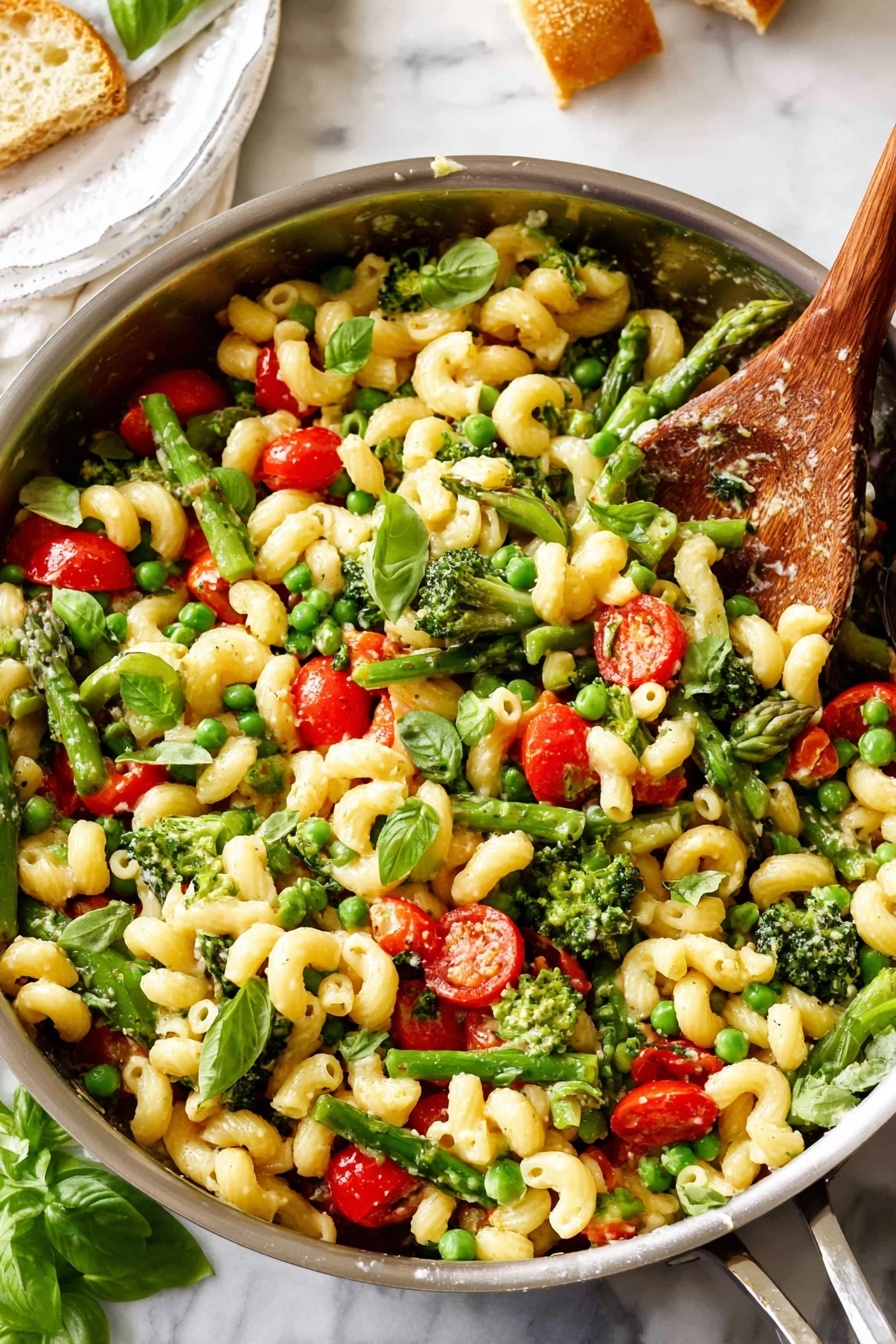
Ingredients & Why They Work
The magic is really in the mix here. The fresh vegetables bring sweetness, crunch, and bright colors while the sauce ties everything together with subtle herbs and a bit of tang from lemon juice. When shopping, look for the freshest produce you can find—this recipe shines brightest when the veggies are at their peak.
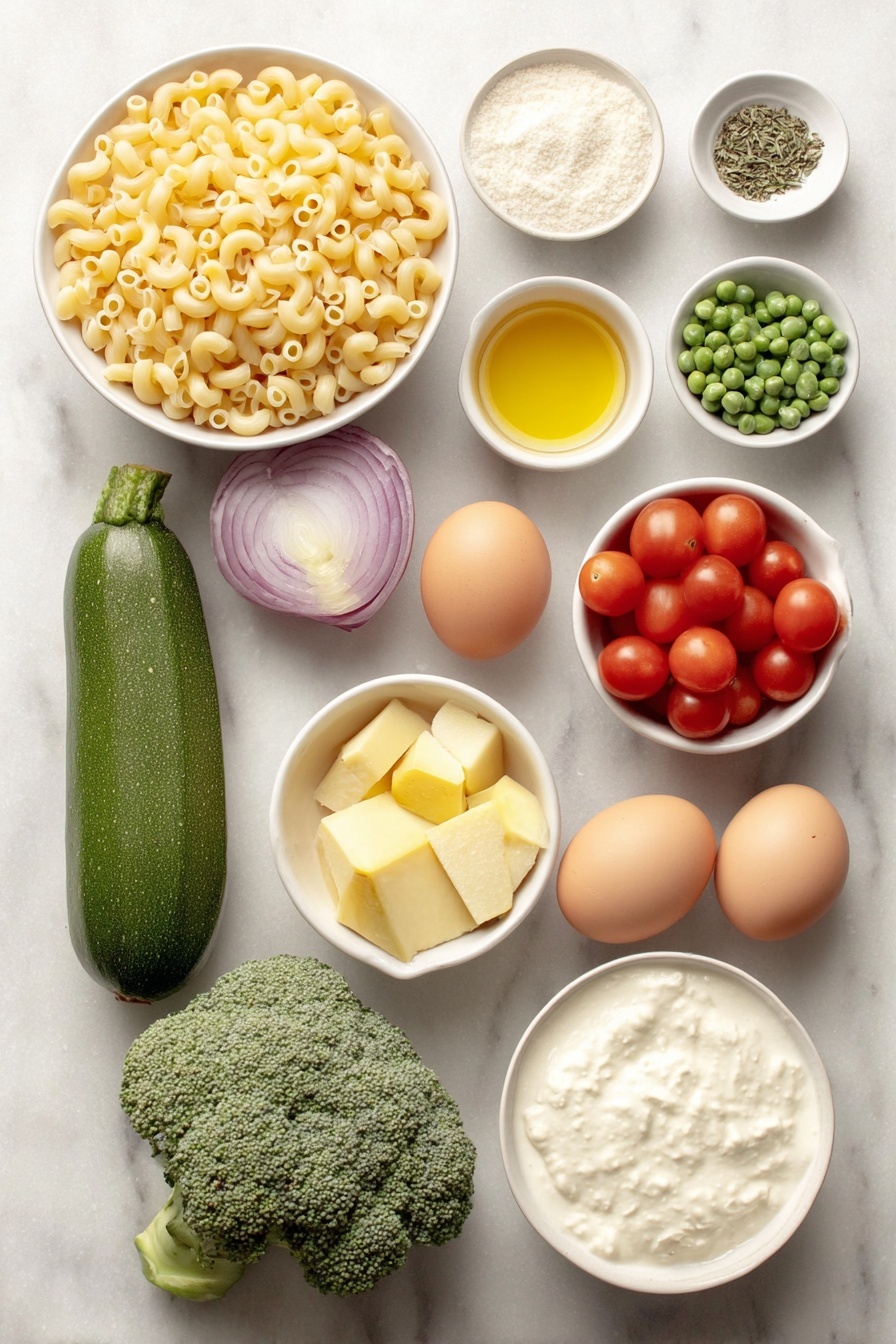
- Cavatappi or short pasta: I love cavatappi because its spiral shape catches the sauce perfectly, but fusilli or penne work great too.
- Extra virgin olive oil: Adds depth and richness; make sure it’s good quality since you taste it.
- Red onion: Gives a gentle pungency and sweetness after sautéing.
- Broccoli florets: Adds a nice green crunch while melding with the creaminess.
- Yellow squash and zucchini: Their mild flavor absorbs the herbs and sauce beautifully.
- Asparagus: A classic primavera ingredient that packs texture and fresh flavor.
- Red bell pepper: Sweetness and vibrant color that complements the other veggies.
- Cherry tomatoes: I love the bursts of juicy brightness they bring as they soften.
- Garlic and red pepper flakes: For an aromatic base with just a hint of spice.
- Heavy cream (or evaporated milk): Creates a silky sauce; evaporated milk is a lighter swap that still works nicely.
- Chicken broth: Adds savory depth and balances the cream.
- Cornstarch: Helps the sauce thicken just right without heaviness.
- Oregano, parsley, thyme: Classic herbs that bring an earthy, herbal flourish.
- Lemon juice: My secret weapon for brightening everything and cutting richness.
- Parmesan cheese: Freshly grated, it melts into creamy perfection and adds that salty, nutty kick.
- Frozen petite peas: Sweet little pops of green that surprise you with texture and flavor.
- Fresh basil: Essential for its aromatic punch and freshness at the finish.
Make It Your Way
This Fresh Vegetable Pasta Primavera Recipe is a perfect starting point, but I love playing around with it depending on what’s in my fridge or what flavors I’m craving. Don’t be shy to make it your own!
- Variation: I sometimes swap seasonal veggies like peas for green beans or toss in mushrooms for a meatier texture. Last summer, I added grilled chicken pieces for a heartier dinner that still felt fresh.
- Dietary swaps: For a dairy-free version, try using coconut cream and nutritional yeast instead of cream and Parmesan.
- Make it spicy: If you like heat, feel free to bump up the crushed red pepper flakes – just the right amount to wake up your taste buds.
Step-by-Step: How I Make Fresh Vegetable Pasta Primavera Recipe
Step 1: Get that pasta perfect
Start by cooking your pasta in salted water just like the package says—except I always check a couple minutes early to make sure it’s al dente, so it still has a little bite. Don’t forget to scoop out and save about half a cup of the pasta water before draining—it’s liquid gold for adjusting the sauce later!
Step 2: Sauté your veggies just right
Heat most of your olive oil in a large pan over medium-high heat. Start with the onions and broccoli—they need a bit more time to soften. Then toss in the squash, zucchini, asparagus, bell peppers, and cherry tomatoes. Season lightly and sauté until the veggies are perfectly tender-crisp. This is key—don’t overcook them or you’ll lose that fresh bite and color. Once done, set them aside in a big bowl.
Step 3: Build the sauce
Wipe out the pan and add the last tablespoon of olive oil. Toss in garlic and red pepper flakes, cooking just until fragrant—30 seconds is enough to avoid burning. Lower the heat, then stir in cream to cool the pan down a bit. Whisk in the chicken broth mixed with cornstarch along with your dried herbs and a pinch of salt. Let it simmer gently until it thickens, about 3 to 5 minutes.
Step 4: Finish strong with cheese, lemon, peas, and basil
Turn the heat to low, add half the Parmesan, and stir until melted and creamy. Next, in goes the lemon juice to brighten things up, along with defrosted peas and fresh basil leaves—stir gently to warm everything through without losing that fresh color.
Step 5: Toss it all together and season
Add the sautéed vegetables back into the sauce, then fold in the drained pasta. If the sauce feels too thick, splash in reserved pasta water little by little until you get the perfect silky texture. Taste and tweak salt and pepper as needed, then sprinkle the remaining Parmesan on top—or dive right in!
Top Tip
Making this Fresh Vegetable Pasta Primavera Recipe a success is all about balancing texture and timing. From my kitchen to yours, here are the top tips I’ve learned that make a world of difference.
- Don’t overcook the veggies: Keep them tender-crisp for maximum flavor and the freshest texture. I always set a timer because it's easy to get distracted and end up with mushy veggies.
- Test pasta early: Pasta continues to cook once drained, so try for al dente—firm to the bite—for the best leftover texture and reheating results.
- Save that pasta water: A splash adds magic to your sauce, helping it cling to the pasta without getting gloopy.
- Use freshly grated Parmesan: It melts better and has richer flavor than store-bought pre-grated cheese — trust me, it’s worth the extra grating.
How to Serve Fresh Vegetable Pasta Primavera Recipe
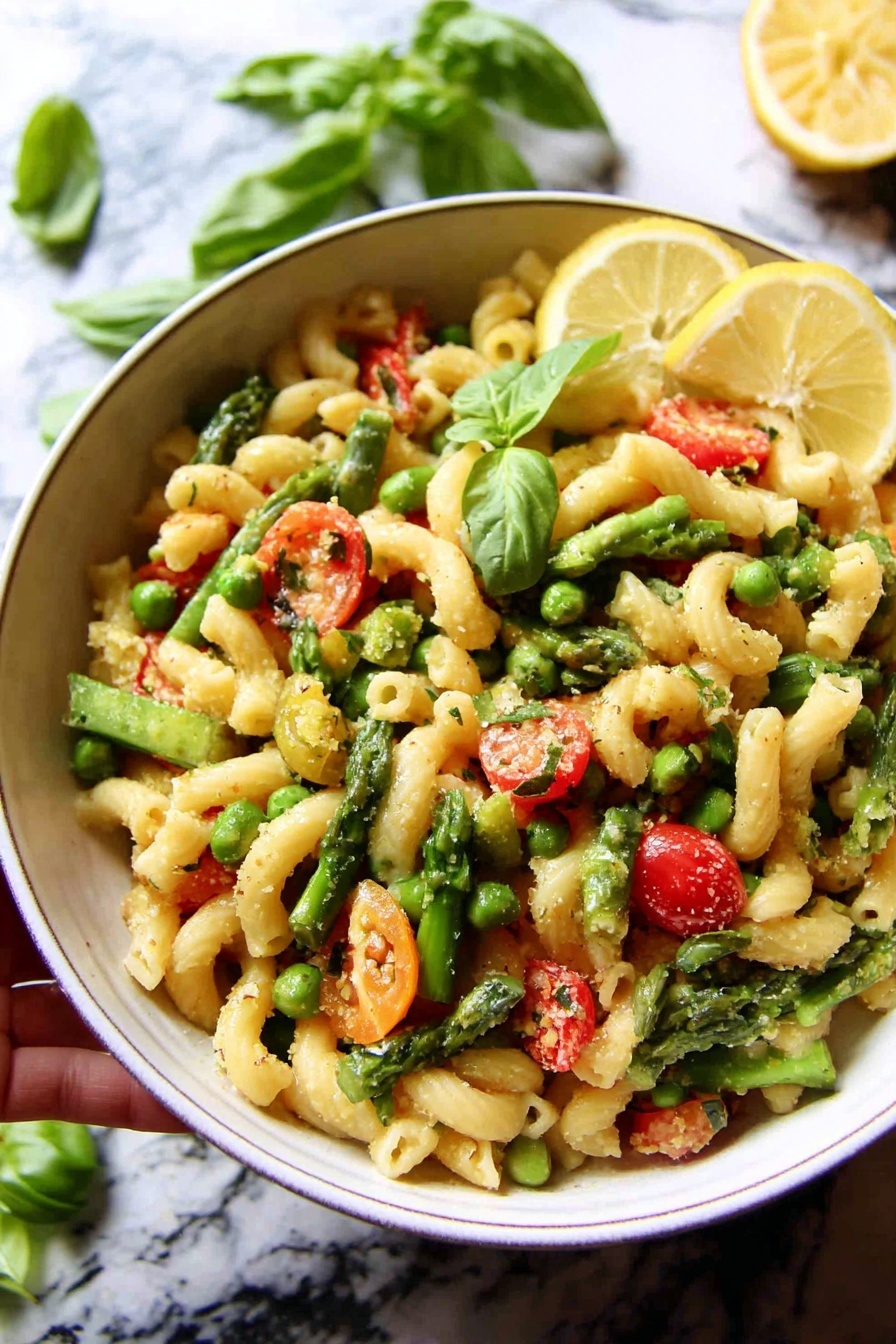
Garnishes
I keep garnishes simple yet fresh—more torn basil leaves, an extra sprinkle of Parmesan, and if I’m feeling fancy, a drizzle of high-quality olive oil or a few cracks of black pepper right before serving. Sometimes a squeeze of fresh lemon adds even more pop.
Side Dishes
Because this dish is so filling and veggie-rich, I usually pair it with a crisp green salad dressed in a light vinaigrette, or some crusty garlic bread to mop up every last bit of sauce. Occasionally, grilled chicken or shrimp on the side adds a nice protein punch.
Creative Ways to Present
For celebrations, I serve the pasta in individual shallow bowls with a colorful array of veggies displayed on top in a pretty pattern. Adding edible flowers or microgreens on top adds a wow factor that guests love. A rustic wooden board piled with lemon wedges and herb sprigs makes the table look inviting.
Make Ahead and Storage
Storing Leftovers
Leftovers? Absolutely! I transfer the pasta primavera into an airtight container once cooled and keep it refrigerated up to five days. It reheats beautifully thanks to the al dente pasta and fresh veggies.
Freezing
I've found freezing this pasta is a bit hit or miss because the sauce can separate and the veggies soften more. If you freeze, store in small portions and thaw overnight in the fridge to help keep texture as good as possible.
Reheating
For quick reheating, microwave with a splash of milk or water, stirring every 30 seconds. For larger batches, reheat gently in a pan over medium-low heat, adding liquid if needed to loosen the sauce and prevent sticking.
Frequently Asked Questions:
Yes! To make it vegan, substitute the heavy cream with a plant-based cream like coconut or cashew cream, use vegetable broth instead of chicken broth, and replace Parmesan with nutritional yeast or vegan cheese alternatives. Adjust seasoning to taste.
Short, sturdy pasta shapes like cavatappi, penne, fusilli, or orecchiette work best because their shapes hold the sauce and vegetables well, giving you that great texture combination in every bite.
Sauté vegetables just long enough to be tender-crisp and use a timer to keep track. Don’t overcrowd your pan, cook in batches if needed, and reserve softer veggies like tomatoes to add towards the end so they don’t overcook.
Absolutely! Cooked grilled chicken, shrimp, or Italian sausage are great additions. Keep in mind that adding protein means adjusting the veggies or sauce quantity to maintain balance, so either reduce some vegetables or increase the sauce for the best result.
Final Thoughts
This Fresh Vegetable Pasta Primavera Recipe holds a special spot in my kitchen for good reason—it’s vibrant, feel-good food that’s nourishing and simple to make. I hope you enjoy the bright flavors and textures as much as I do. When you make it, remember, you’re not just cooking pasta—you’re creating a colorful, comforting meal that feels like a celebration of fresh garden goodness. Have fun with it and make it your own!
Print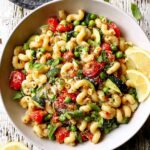
Fresh Vegetable Pasta Primavera Recipe
- Prep Time: 15 minutes
- Cook Time: 15 minutes
- Total Time: 30 minutes
- Yield: 6 servings
- Category: Main Course
- Method: Stovetop
- Cuisine: Italian
- Diet: Vegetarian
Description
Pasta Primavera is a vibrant and fresh Italian-inspired dish featuring a medley of sautéed vegetables tossed with al dente pasta in a creamy, herbaceous Parmesan sauce. This recipe balances tender-crisp veggies with a luscious, comforting cream sauce complemented by fresh basil and lemon juice, making it perfect for a light yet satisfying meal.
Ingredients
Pasta
- 12 oz. cavatappi or other short pasta such as penne, fusilli, or orecchiette
Vegetables
- ½ medium red onion chopped
- 2 cups broccoli florets cut into 1-inch pieces
- 1 medium yellow squash sliced and quartered
- 1 medium zucchini sliced and quartered
- 8 oz asparagus trimmed, cut into 1 ½-inch pieces
- 1 medium red bell pepper chopped
- 1 ½ cup cherry tomatoes halved
- 1 ½ cups frozen petite peas thawed
- ¼ cup fresh basil chopped
- salt and pepper to taste
Sauce
- 4 tablespoons extra virgin olive oil divided
- 4 cloves garlic minced
- ¼ teaspoon red pepper flakes
- 1 cup heavy cream (may substitute evaporated milk)
- 1 ½ cups chicken broth
- 1 tablespoon cornstarch
- 1 ½ teaspoon dried oregano
- 1 ½ teaspoon dried parsley
- ½ teaspoon dried thyme
- 2 tablespoons lemon juice
- ¾ cup freshly grated Parmesan cheese divided
Instructions
- Cook Pasta: Bring a large pot of salted water to a boil and cook the pasta according to package directions until al dente. Reserve ½ cup of the pasta water before draining the pasta.
- Sauté Vegetables: In a large, deep saucepan or skillet, heat 3 tablespoons of olive oil over medium-high heat. Add the chopped red onion and broccoli florets and sauté for 3 minutes.
- Add More Vegetables: Add the yellow squash, zucchini, asparagus, red bell pepper, and cherry tomatoes to the pan. Season with ¼ teaspoon salt and ¼ teaspoon pepper, and sauté for 2 minutes until the vegetables are tender-crisp. Transfer the cooked vegetables to a large bowl and set aside.
- Prepare Sauce Base: In the same skillet, heat the remaining 1 tablespoon of olive oil over medium heat. Add the minced garlic and red pepper flakes and sauté for 30 seconds until fragrant.
- Make Cream Sauce: Lower the heat to low, then add the heavy cream. In a separate bowl, whisk the chicken broth with cornstarch until smooth, then pour this mixture into the skillet. Add dried oregano, parsley, thyme, and ¼ teaspoon salt. Bring the sauce to a simmer and cook for 3-5 minutes until it thickens.
- Finish Sauce: Stir in ½ cup of freshly grated Parmesan cheese until melted, then add the lemon juice, thawed peas, and chopped fresh basil. Warm through gently on low heat.
- Combine Pasta and Veggies: Add the sautéed vegetables back into the sauce, then add the cooked pasta. Stir to combine everything evenly, adding reserved pasta water a tablespoon at a time if the sauce needs thinning. Taste and adjust seasoning with salt and freshly cracked pepper.
- Serve: Garnish with the remaining ¼ cup Parmesan cheese or more to taste. Serve warm.
Notes
- Don’t overcook your vegetables; they should be tender-crisp to preserve texture and flavor.
- Cook pasta al dente by testing a few minutes before package directions to maintain a pleasant bite.
- Use a large and deep pan such as a saucepan, braiser, or Dutch oven to comfortably cook vegetables and pasta together.
- You can substitute or add other vegetables, ensuring a mix of textures and colors for balance.
- For convenience, use a stir-fry vegetable mix, chopping as needed for even cooking times.
- If adding protein, adjust vegetable and sauce quantities accordingly to maintain balance.
- Always use freshly grated Parmesan cheese for the best melting and flavor experience.
- Adjust lemon juice to taste for a more or less lemony profile.
- Store leftovers in an airtight container in the refrigerator for up to five days.
- Reheat gently in the microwave with a splash of milk or water, or on the stovetop over medium-low heat, stirring frequently.
- To prep ahead, cook pasta al dente and toss with oil to prevent sticking; store vegetables, aromatics, and cheese separately.
Nutrition
- Serving Size: 1 serving
- Calories: 420 kcal
- Sugar: 5 g
- Sodium: 450 mg
- Fat: 18 g
- Saturated Fat: 7 g
- Unsaturated Fat: 10 g
- Trans Fat: 0 g
- Carbohydrates: 50 g
- Fiber: 6 g
- Protein: 15 g
- Cholesterol: 40 mg


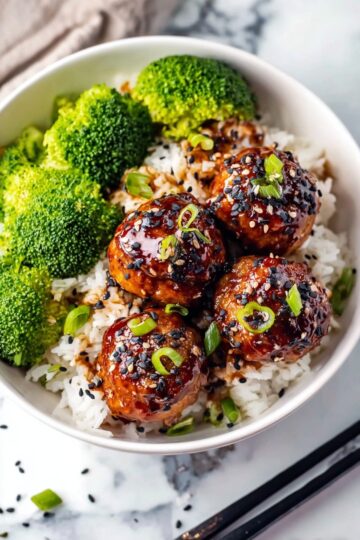
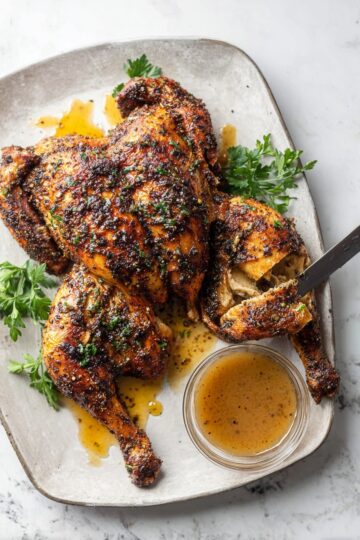

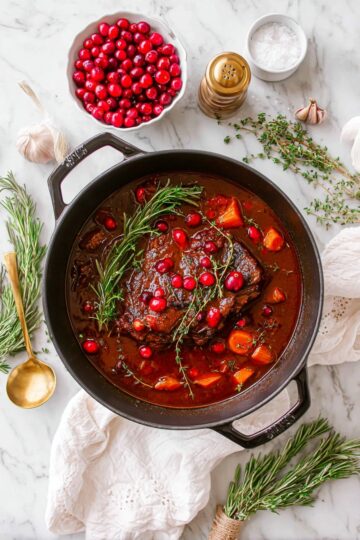
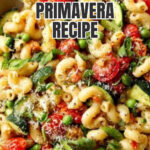
Leave a Reply